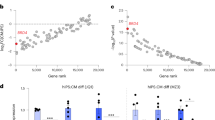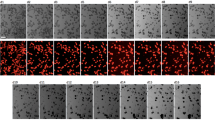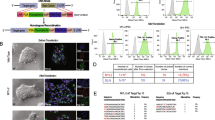Abstract
NKX2-5 is expressed in the heart throughout life. We targeted eGFP sequences to the NKX2-5 locus of human embryonic stem cells (hESCs); NKX2-5eGFP/w hESCs facilitate quantification of cardiac differentiation, purification of hESC-derived committed cardiac progenitor cells (hESC-CPCs) and cardiomyocytes (hESC-CMs) and the standardization of differentiation protocols. We used NKX2-5 eGFP+ cells to identify VCAM1 and SIRPA as cell-surface markers expressed in cardiac lineages.
This is a preview of subscription content, access via your institution
Access options
Subscribe to this journal
Receive 12 print issues and online access
$259.00 per year
only $21.58 per issue
Buy this article
- Purchase on Springer Link
- Instant access to full article PDF
Prices may be subject to local taxes which are calculated during checkout



Similar content being viewed by others
Accession codes
References
Yao, S. et al. Proc. Natl. Acad. Sci. USA 103, 6907–6912 (2006).
Tomescot, A. et al. Stem Cells 133, 2200–2205 (2007).
Paige, S.L. et al. PLoS ONE 5, e11134 (2010).
Dambrot, C., Passier, R., Atsma, D. & Mummery, C.L. Biochem. J. 434, 25–35 (2011).
Christoforou, N. et al. J. Clin. Invest. 118, 894–903 (2008).
Satin, J. et al. Stem Cells 26, 1961–1972 (2008).
Sedan, O. et al. Stem Cells 26, 3130–3138 (2008).
Kehat, I. et al. J. Clin. Invest. 108, 407–414 (2001).
Dick, E., Rajamohan, D., Ronksley, J. & Denning, C. Biochem. Soc. Trans. 38, 1037–1045 (2010).
Yang, L. et al. Nature 453, 524–528 (2008).
Bu, L. et al. Nature 460, 113–117 (2009).
Laflamme, M.A. et al. Nat. Biotechnol. 25, 1015–1024 (2007).
Hattori, F. et al. Nat. Methods 7, 61–66 (2010).
Lints, T.J., Parsons, L.M., Hartley, L., Lyons, I. & Harvey, R.P. Development 119, 419–431 (1993).
Kwee, L. et al. Development 121, 489–503 (1995).
Dubois, N.C. et al. Nat. Biotechnol. (in the press).
Osoegawa, K. et al. Genome Res. 11, 483–496 (2001).
Costa, M. et al. Nat. Protoc. 2, 792–796 (2007).
Davis, R.P. et al. Nat. Protoc. 3, 1550–1558 (2008).
Reubinoff, B.E., Pera, M.F., Fong, C.Y., Trounson, A. & Bongso, A. Nat. Biotechnol. 18, 399–404 (2000).
Ng, E.S., Davis, R., Stanley, E.G. & Elefanty, A.G. Nat. Protoc. 3, 768–776 (2008).
Ng, E.S., Davis, R.P., Azzola, L., Stanley, E.G. & Elefanty, A.G. Blood 106, 1601–1603 (2005).
Burridge, P.W. et al. Stem Cells 25, 929–938 (2007).
Pick, M., Azzola, L., Mossman, A., Stanley, E.G. & Elefanty, A.G. Stem Cells 25, 2206–2214 (2007).
Davis, R.P. et al. Blood 111, 1876–1884 (2008).
Goulburn, A.L. et al. Stem Cells 29, 462–473 (2011).
Mummery, C. et al. Circulation 107, 2733–2740 (2003).
Passier, R. et al. Stem Cells 23, 772–780 (2005).
Prall, O.W. et al. Cell 128, 947–959 (2007).
Graichen, R. et al. Differentiation 76, 357–370 (2008).
Acknowledgements
This work was funded by the Australian Stem Cell Centre (to E.G.S., A.G.E., D.A.E., D.M.K., J.M.H. and C.W.P.), the National Health and Medical Research Council of Australia (D.A.E., grant 606586; O.W.J.P., grant 573707), National Heart Foundation (Australia) (E.G.S. and A.G.E., grant G 08M 3711; O.W.J.P., Career Development Award grant CR 08S 3958), the Netherlands Organization for Scientific Research and the Netherlands Institute of Regenerative Medicine (S.R.B. and C.L.M.), the Victorian State Government Operational Infrastructure Support and the National Health and Medical Research Council of Australia's Independent Research Institutes Infrastructure Support Scheme (O.W.J.P. and C.B.). R.P.D. is funded by a Rubicon fellowship from the Netherlands Organization for Scientific Research and the Marie Curie Co-fund Action. E.G.S. and A.G.E. receive Senior Research Fellowships and D.M.K. receives a Principal Research Fellowship from the National Health and Medical Research Council of Australia.
Author information
Authors and Affiliations
Contributions
D.A.E., A.G.E., E.G.S. and C.L.M. designed the study. D.A.E., S.R.B., K.K., E.S.N., R.J., E.L.L., C.B., T.H., R.J.P.S., O.K., D.W.O., X.L., S.M.H., S.M.L., R.P., R.P.D., A.L.G., O.W.J.P., A.G.E., X.L., S.M.H., J.M.H., C.W.P. and D.M.K. performed and analyzed experiments. C.E.H. and Q.C.Y. performed bioinformatics analyses. D.A.E., C.L.M., A.G.E. and E.G.S. wrote the manuscript.
Corresponding authors
Ethics declarations
Competing interests
D.A.E., A.G.E. and E.G.S. have applied for a patent (US provisional USSN 61/492,099) in relation to results described in this paper.
Supplementary information
Supplementary Text and Figures
Supplementary Figures 1–8, Supplementary Tables 1–3 (PDF 4994 kb)
Supplementary Video 1
NKX2-5eGFP/w derived embryoid bodies express eGFP in contractile areas. Brightfield and green fluorescence of a day-14 NKX2-5eGFP/w embryoid body. This video demonstrates that contractile areas of the embryoid body express eGFP. (MOV 774 kb)
Supplementary Video 2
NKX2-5eGFP/w hESC cultured with the END2 endodermal cell line express eGFP in contractile areas. Movie shows a Z-dimension stack through the beating area demonstrating that eGFP is expressed with contracting clusters. (MOV 2962 kb)
Supplementary Video 3
Calcium flux across a contraction cycle. Green fluorescence (top left). Red fluorescence (top right). Brightfield (bottom left). Pseudo-colored video showing calcium flux (bottom right). (MOV 1931 kb)
Supplementary Video 4
Monolayer differentiation with NKX2-5eGFP/w hESCs. Brightfield and green fluorescence shows that beating foci are eGFP+. (MOV 936 kb)
Rights and permissions
About this article
Cite this article
Elliott, D., Braam, S., Koutsis, K. et al. NKX2-5eGFP/w hESCs for isolation of human cardiac progenitors and cardiomyocytes. Nat Methods 8, 1037–1040 (2011). https://doi.org/10.1038/nmeth.1740
Received:
Accepted:
Published:
Issue Date:
DOI: https://doi.org/10.1038/nmeth.1740
This article is cited by
-
HAND factors regulate cardiac lineage commitment and differentiation from human pluripotent stem cells
Stem Cell Research & Therapy (2024)
-
Surfaceome mapping of primary human heart cells with CellSurfer uncovers cardiomyocyte surface protein LSMEM2 and proteome dynamics in failing hearts
Nature Cardiovascular Research (2023)
-
Pluripotent stem cell-derived committed cardiac progenitors remuscularize damaged ischemic hearts and improve their function in pigs
npj Regenerative Medicine (2023)
-
Mass production of lumenogenic human embryoid bodies and functional cardiospheres using in-air-generated microcapsules
Nature Communications (2023)
-
Fluorescent hiPSC-derived MYH6-mScarlet cardiomyocytes for real-time tracking, imaging, and cardiotoxicity assays
Cell Biology and Toxicology (2023)



